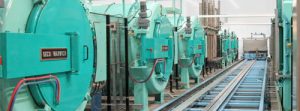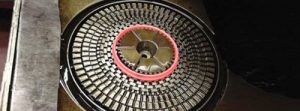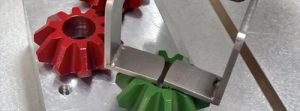
In this column, I will discuss the transformation of bainite from austenite.
Introduction
During the late 1920s, during studies of isothermal transformation of austenite — at temperatures above martensite formation, but below martensite transformation — Davenport and Bain [1] discovered a microstructure that etched differently than martensite or pearlite. This microstructure was named bainite in honor of E.C. Bain.
This microstructure was unique in that it formed under continuous cooling or under isothermal conditions, with a structure that was like both martensite and bainite. Pearlite contains a mixture of ferrite and iron carbide, and is diffusion controlled. Martensite is non-lamellar and not diffusion controlled. Bainite showed both the characteristics of pearlite and martensite, depending on the temperature of formation. Two different morphologies of bainite were observed: upper bainite that formed just below pearlite, and lower bainite that forms at just above the Ms temperature.

It has a similar appearance to tempered martensite (Figure 1), with a feathery appearance. It is very similar to tempered martensite in terms of hardness and toughness. Because of the difficulty in controlling the formation of bainite, it generally has limited applicability, except for austempering.
This is a process using molten salts where bainite is formed on isothermal holding at approximately 325°C (620°F). This process is used when a hard and tough structure is needed, in thin sections. Figure 2 shows the morphology of bainite compared to martensite.
In general, the formation of bainite is suppressed by many alloying elements. However, carbon has the strongest effect. An empirical equation for the start temperature for the formation of bainite (Bs) is [2]:

Note that all alloy concentrations are in weight percent.
Transformation
Unlike martensitic transformation, which occurs via a diffusionless mechanism, bainite formation is associated with both diffusional and diffusionless processes. Bainite itself is a microstructure consisting of ferrite and cementite (Fe3C) or, in some cases, a carbide-free version known as bainitic ferrite. Bainite typically forms at temperatures lower than those at which pearlite forms, but higher than the temperature range for martensitic transformation.
Bainite is not a single phase but a composite microstructure consisting of bainitic ferrite laths or plates and carbon-enriched residual austenite. The morphology and distribution of these constituents depend on the transformation temperature (Table 1).

Bainite formation is controlled by the Gibbs free energy changes associated with the phase transformation from austenite (FCC structure) to ferrite (BCC structure) [3]. The austenite-to-bainite transition involves a decrease in free energy, which is driven by both the temperature and carbon concentration in the alloy. The driving force for bainite formation is the difference in free energy between austenite and bainite, ΔG(γ→α), which depends on temperature, composition, and applied stress [4] [5]. As temperature decreases, the driving force increases, but so does the energy barrier for atomic rearrangement.
The nucleation of bainite is often considered to occur through a heterogeneous process at sites of high energy, such as grain boundaries, dislocations, or pre-existing defects in the microstructure. The nucleation rate depends on the degree of undercooling below the critical transformation temperature and interfacial energy [6]. At higher temperatures, nucleation is typically slow, while at lower temperatures, nucleation accelerates due to an increase in the driving force for transformation.

Bainite nucleation is not a purely diffusionless process, as it involves a combination of both short-range atomic diffusion and dislocation motion. The local concentration of carbon in the austenite influences the nature of the nucleation sites and the microstructural evolution. In some instances, bainitic ferrite nucleates at the interface of austenite grains, where the carbon concentration is locally enhanced due to segregation. Carbon partitioning occurs immediately after the formation of each lath, enriching the residual austenite [3].
Once nucleated, the growth of bainite involves the formation of ferrite laths or plates that propagate through the austenite matrix by a shear mechanism [6]. The growth of bainitic ferrite is governed by the diffusion of carbon, which is initially rejected from the ferrite phase and precipitates as cementite (Fe3C) or forms a carbide-free bainitic structure under certain conditions.
The growth mechanism is influenced by temperature, with growth rates being faster at higher temperatures. The carbon content in the austenite also affects the growth of the bainitic laths, as higher carbon concentrations retard the growth of ferrite and encourage carbide precipitation. The resulting microstructure may consist of fine plates of ferrite with dispersed cementite, or it may contain a more complex morphology depending on the carbon content and transformation temperature.
The characteristic microstructure of bainite consists of a fine-scale mixture of ferrite and cementite, though the morphology of these phases can vary depending on the alloy composition and heat-treatment parameters. Bainite can be broadly classified into two types: upper and lower bainite.
Upper bainite forms at higher transformation temperatures, typically above 400°C. It consists of ferrite laths with coarse cementite precipitates. The structure is often less refined and coarser compared to lower bainite.
Lower bainite forms at lower transformation temperatures (below 400°C) and exhibits a finer, more uniform microstructure. The ferrite laths are finer, and the cementite precipitates are smaller and more dispersed throughout the matrix.
The bainitic ferrite phase is characterized by a plate-like morphology, where each plate or lath forms through the growth of a thin interface that propagates through the austenite. The cementite particles (Fe3C) can be either globular or lamellar, depending on the transformation conditions and cooling rates.
Conclusion
The transformation of austenite to bainite is a complex process, involving displacive nucleation and growth of ferrite laths, and rapid carbon partitioning to the retained austenite.
Should there be any questions regarding this article, or suggestions for further articles, please contact the writer or the editor.
References
- E. S. Davenport and E. C. Bain, “Transformation of austenite at constant subcritical temperatures,” Trans. Met. Soc. AIME, vol. 90, pp. 117-154, 1930.
- W. Steven and A. G. Haynes, J. of Iron and Steel Institute, vol. 183, p. 349, 1956.
- H. K. D. H. Bhadeshia, Bainite in Steels, London: IOM Communications, 2001.
- Z. C. W. K. H. M. P. U. S. R. Lin M, “Modeling Bainitic Transformations during Press Hardening,” Materials (Basel), vol. 14, no. 3, p. 654, Jan 2021.
- S. X. J. L. T. D. R.P. Garrett, “A model for predicting austenite to bainite phase transformation in producing dual phase steels,” International Journal of Machine Tools and Manufacture, vol. 44, no. 7-8, pp. 831-867, 2004.
- D. Quidort and Y. J. Brechet, “A Model of Isothermal and Non-Isothermal Transformation Kinetics of Bainite in 0.5% C Steels,” ISJI Int., vol. 42, no. 9, pp. 1010-1017, 2002.
- S. Babu and H. Bhadeshia, “Mechanism of the Transition from Bainite to Acicular Ferrite,” Mat. Trans., vol. 32, no. 8, pp. 679-688.























